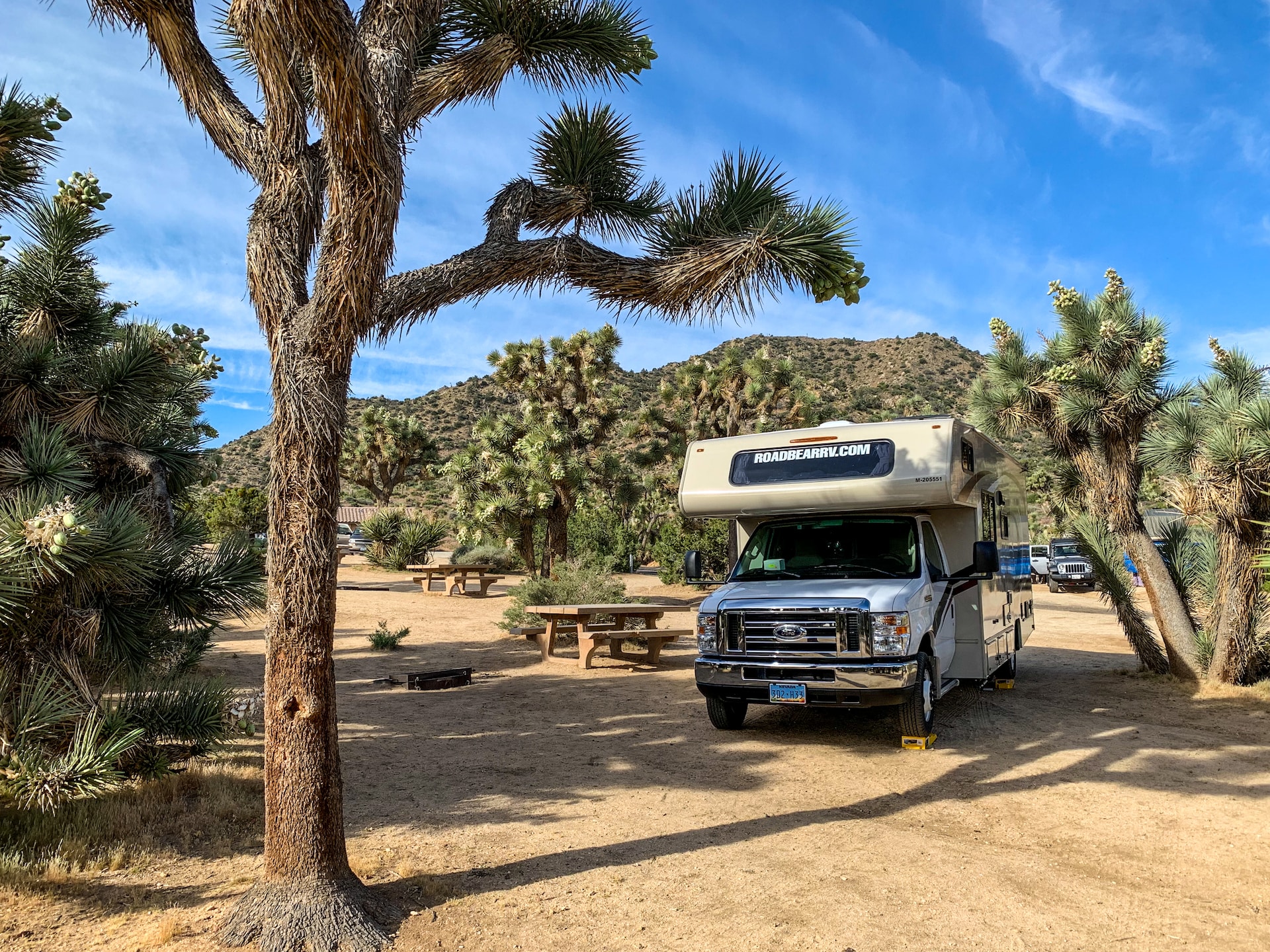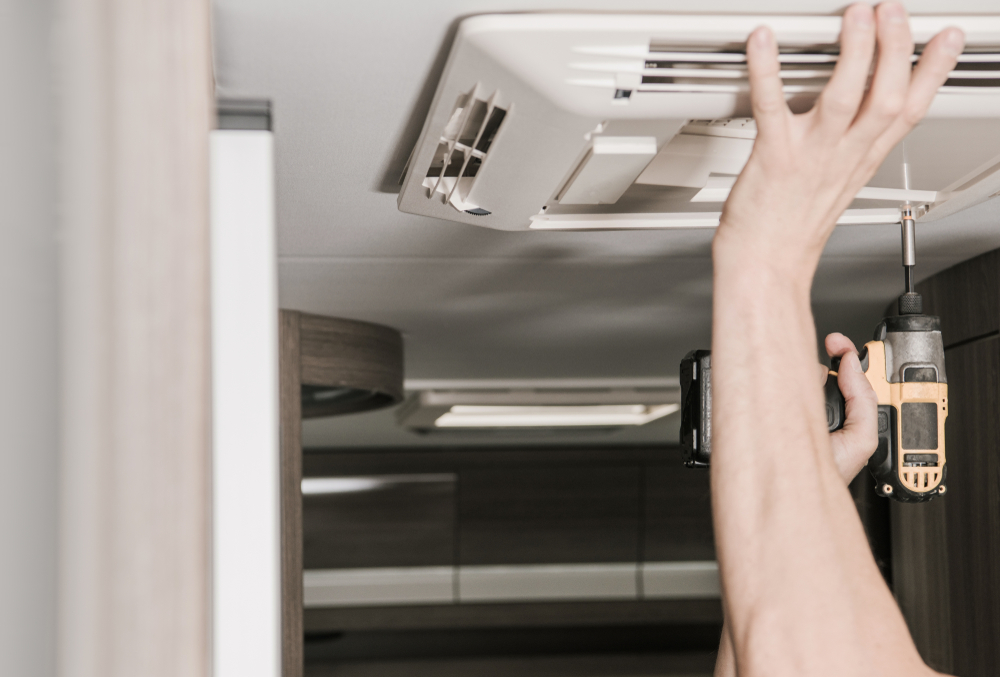
Solar 101
Can Solar Panels Power an RV Air Conditioner?
Optivolt
June 5, 2023
6 min read
If you're putting together an RV solar power system, you may be wondering what you can power with it. Low-power devices are easy to accommodate, but what about high-wattage appliances like an off-grid air conditioner?
A solar power system can power an RV AC unit. With enough solar panels, you can power just about any appliance. The bigger concern is how many solar panels are required to power an AC unit. Roof space and budget will limit the number of solar panels that you are able to drive around with.
In this article, we will explore the amount of power that an RV AC unit consumes, which will help us determine how many solar panels are needed to keep your RV cool.

How Much Power Does an RV AC Unit Use?
A typical 13,500 BTU RV air conditioning unit may draw 2750 watts at startup and 1,250 watts while running. If the AC unit is operating for 3 hours per day, it will consume 3,750 watt-hours (Wh) per day, or 3.75 kWh (energy = power x time, so Wh = Watts x Hours).
A camper van may be able to get away with a smaller AC unit, such as a 7,000 BTU RV air conditioner rated for 600 running watts. This unit will consume 1,800 Wh if it runs for 3 hours per day.
How Many Solar Panels to Run My RV AC Unit?
In order to calculate the number of solar panels we need to operate an off-grid AC unit, we have to determine the amount of power we want to supply. If we plan to run a 1,250W AC unit for 3 hours per day, then we need to produce at least 3,750 Wh each day.
Consider this formula for determining the wattage of a solar array:
Array Wattage = Desired Energy Production ÷ Sun Hours
If you are using an AC Unit, we can assume that you will be receiving summer levels of peak sun: at least 4 hours per day, depending on your location. In the winter, peak sun hours may fall to about 2 per day (which makes it difficult to power an electric RV heating system).
If we fill in the information that we already have, our equation now looks like this:
Array Wattage = 3,750 Wh ÷ 4 Sun Hours = 937.5 watts
So, in order to power this AC unit for 3 hours per day while receiving 4 peak sun hours, we would need a solar array with a total wattage of at least 937.5 watts. An array of ten 100W solar panels (or three 400W panels) is needed to power this RV AC unit in optimal summer conditions.
Note that you will need additional panels to power the other appliances and devices in your RV, such as phones, lights, and laptops. View our solar array sizing guide for more details on calculating the number of panels you need for an entire RV solar power system.

Solar Components Required to Run an RV Air Conditioner
An RV requires more than just solar panels to supply power to an AC unit. The power produced by solar panels needs to be stored for later use, safely transferred throughout the system, and converted into usable energy. Every RV solar power system is different, but most will include at least these components:
- Battery Bank: Once the sun goes down, your panels stop producing power. A battery bank stores solar energy for later use, allowing you to power devices and appliances even when your solar panels are not producing power.
- Charge Controller: The solar charge controller is wired in between the solar panels and the battery bank. This device regulates the battery charging process, providing safety and optimization. Without it, your solar panels may overcharge the battery bank. Most charge controllers can also power basic DC loads like lighting.
- Inverter: The power generated by solar panels is direct current (DC). Most RV air conditioners run on alternating current (AC) power. An inverter converts DC power into AC power that can be used by RV AC units and other appliances.
- Wiring and Connectors: Everything needs to be joined together with the proper wire gauges and connectors to ensure a safe system.
If you are not interested in purchasing and connecting your own solar components, other options are available. Portable power stations (also referred to as solar generators) are a popular alternative. They are a convenient, all-in-one solution that packs all of the solar components into one package with no assembly required. They do have a higher upfront cost, so you need to decide if the convenience is worth the price.
Do I Need an Inverter?
The typical off-grid air conditioner operates on 120V AC power. In order to run a 120V AC appliance using solar power, you need an inverter to convert the power produced by solar panels from DC to AC.
If you happen to have a 12V DC air conditioning unit, then you won't necessarily need an inverter. However, this is a rare case, and an inverter may still be required to power other devices and appliances in your RV.
Inverters have two primary wattage ratings: continuous and peak surge. If a 13,500 BTU RV air conditioning unit is rated for 2750 surge watts and 1250 running watts, then you need an inverter rated for at least these values (while also considering the other appliances that you need to power). In this situation, you might utilize an inverter with ratings of 2000W continuous and 4000W peak surge.
Is Powering an RV AC Unit With Solar Worth It?
In general, powering an RV AC unit is not worth it. The amount of power required to run an RV AC unit can be difficult to harvest using just solar power. This is due to roof space, budget, and other constraints.
Instead of trying to power an off-grid air conditioner, RV owners that want to stick exclusively with solar power should try and follow the seasons: head to cooler weather in the summer, and move south for a warmer winter. That way, you can use your harvested solar power for other appliances and devices.
If you still want to go for it, use high-efficiency solar panels to help you generate more power. Partial shading — a common occurrence with RV solar panels — can cause severe drops in panel output, even when just a small portion is blocked out.
Optivolt produces one-of-a-kind shade tolerant solar panels. The integrated power electronics technology maximizes efficiency in shaded conditions.
